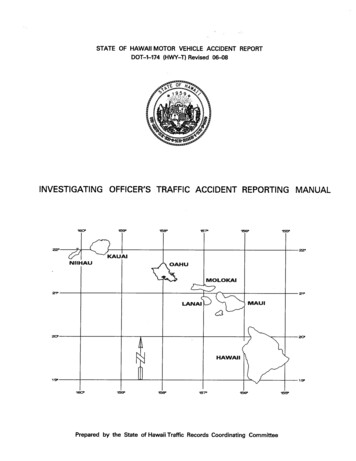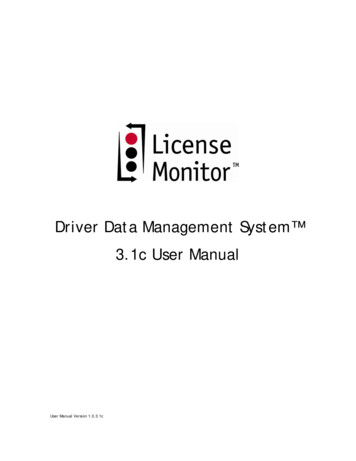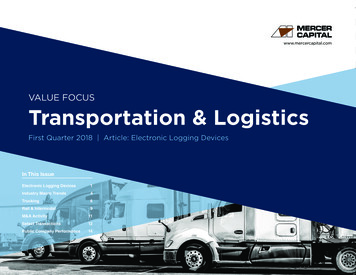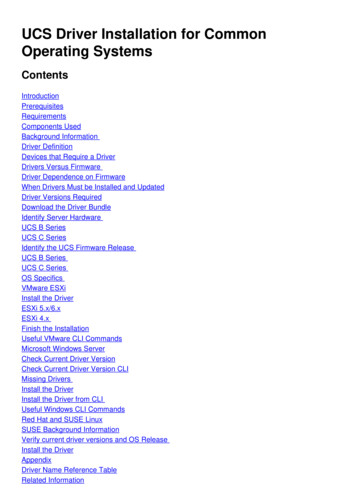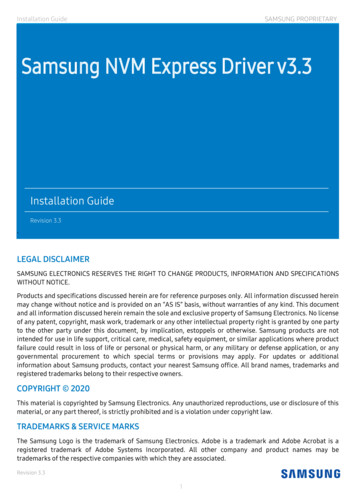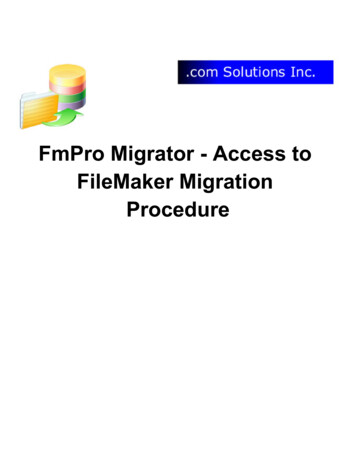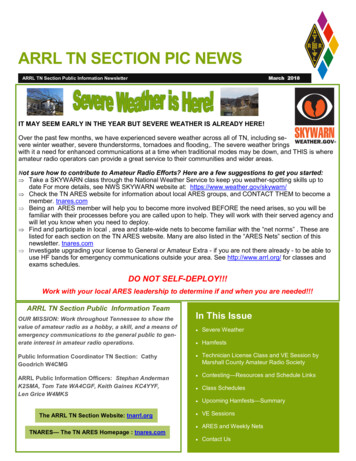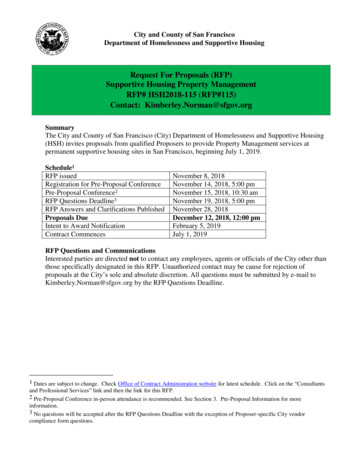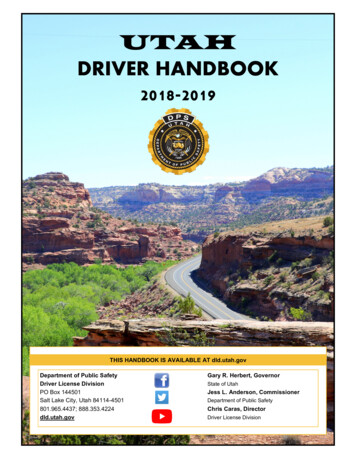
Transcription
UTAHDRIVER HANDBOOK2018-2019THIS HANDBOOK IS AVAILABLE AT dld.utah.govDepartment of Public SafetyDriver License DivisionPO Box 144501Salt Lake City, Utah 84114-4501801.965.4437; 888.353.4224dld.utah.govGary R. Herbert, GovernorState of UtahJess L. Anderson, CommissionerDepartment of Public SafetyChris Caras, DirectorDriver License Division
STATE OF UTAHUTAH DRIVER HANDBOOKAAMVA MODEL NON-COMMERCIALThis handbook is a collaborative effort between AAMVA and the Utah Driver License Divisionand contains the rules which should be followed when operating any vehicle on Utah roads.The operator of a bicycle must obey the same rules of the road, and has the same rights andduties as the operator of a motor vehicle or other vehicle.For additional driver license information and forms visit our website at dld.utah.gov. Please beaware of imitator sites that do not end in .gov.Help conserve our natural resources. When you are finished with this book, please pass it on toa friend or return it to your local Driver License Office.Test your knowledge on the rules of the road with our online practice written knowledge test written-test/.Driver License Division (DLD) Services: Driver License, Commercial Driver License (CDL), Driving Privilege Cards (DPC), LimitedTerm Driver License, Identification Cards, Limited-Term Identification Cards, Endorsements(CDL, Taxi, Motorcycle) Utah Driving Records (MVR) Reinstatement Fees Driver Review Exams Voter Registration Organ Donor Registration
NEW 2018 LAWSEffective May 8, 2018Ignition InterlockHB65—If you are convicted of driving under the influence and the conviction does not involve alcohol, you are not required to be an interlock restricted driver.SuspensionsHB144—The Driver License Division may not suspend a person’s driver license for certainoffenses, unless the person was an operator of a motor vehicle at the time of offense.Pedestrian SafetyHB145—Pedestrians are restricted from certain conduct that may impede and block trafficto include roads with a median, whether raised or flat, a highway where a fixed guidewayor rail line shares the right-of-way with the highway.Auto Registration RequirementsHB161—You no longer have to carry a registration card in your vehicle to be presented toa peace officer.Limited-Term License RevisionsHB189—The term for a limited-term driver license certificate and renewal for an approvedasylee or refugee changed from four years to five years.Effective July 1, 2018Public Safety Fee RevisionsSB16—Changes fee amounts for services provided by the Driver License Division.Effective December 30, 2018Driving Under the Influence RevisionsHB345—Reduces the blood alcohol concentration limit from .08 to a .05.
DRIVER LICENSE HISTORYInteresting facts about the Utah Driver License Division The Bureau of Driver License Services was created on January 1, 1934, when Utah officially adopted the “UniformOperator’s and Chauffeurs’ License Act.” (Prior to this, the State of Utah had no driver license law.) This act required that “every operator of a motor vehicle shall not drive any motor vehicle upon a highway in thisstate unless such person was licensed to do so.” Originally, the Bureau of Driver License Services was an agency within the State Tax Commission. The first license in Utah was issued on December 5, 1933. It cost 25 and was good until revoked. It was printed inblue on white paper. The application card was 6” x 3½” and only asked for name, address, brief description, a few questions and a signature. No examination was given until January 1935, when the eye test, written knowledge test, and an occasional drivingskills test was given. The “good-until-revoked” licenses were issued until December 31, 1935. Beginning January 1, 1936, the law was changed to have the driver license expire three years after issuance (not onthe birthdate.) The fee was still 25 . One of the biggest changes came in 1951 when the Bureau of Driver License Services moved from the State TaxCommission and became an agency within the Department of Public Safety. In 1980, the state decided to reward “good drivers” by developing a system for the applicant to renew their driverlicense through the mail. The Driver License Division began issuing a commercial driver license in 1989. The Driver License Division began offering more online services including MVRs and appointments. In January 2010, the citizens of Utah started a 5-year process that required all Utah drivers to bring in their identification documents once again. This process was a beginning step to meet the licensing practices for the Federal REALID Act. January 2010, the renewal-by-mail program was suspended. February 13, 2013, the Driver License Division was notified by the Department of Homeland Security that Utahmeets the licensing practices of the Federal REAL ID Act. April 2013, the renewal-by-mail program was reinstated and renewal-by-internet was a new service. May 2015, the Driver License Division began offering online CDL MVR services to authorized drivers and employers. In 2016, the Driver License Division stopped conducting driving skills test on an enclosed range. All driving skillstests are performed on public roads. In March 2017, tablets were implemented to score driving skills tests rather than paper. In December 2018, Utah is the first state in the country to have a blood alcohol concentrate of .05.Did you know the Driver License Division is not part of the DMV?Our friends at the DMV (Department of Motor Vehicles, under the Utah State Tax Commission) can assist you at801.297.7780 or dmv.utah.gov.
THE TOP FIVE LEADING CAUSES OF DEATH ON UTAH HIGHWAYS1. Speed Too Fast 37%2. Unrestrained Occupants 31%3. Drunk Driving 13%4. Failed to Yield Right-of-Way 11%5. Failed to Keep in Proper Lane 11%THE TOP FIVE LEADING CAUSES OF CRASHES ON UTAH HIGHWAYS1. Following too Closely 22%2. Failed to Yield Right-of-Way 18%3. Speed Too Fast 18%4. Failed to Keep in Proper Lane 12%5. Distracted Driving 10%THE TOP FIVE LEADING CAUSES OF DEATH ON UTAH HIGHWAYS (TEENAGERS)1. Speed Too Fast 33%2. Failed to Keep in Proper Lane 23%3. Disregard Traffic Signal/Sign 17%4. Overcorrected 17%5. Failed to Yield, Driver Distraction 13%THE TOP FIVE LEADING CAUSE OF CRASHES ON UTAH HIGHWAYS (TEENAGERS)1. Following Too Closely 21%2. Failed to Yield Right-of-Way 18%3. Speed Too Fast 12%4. Driver Distraction 9%5. Failed to Keep In Proper Lane 8%Information based on 2015 statistics provided by the Utah Department of Public Safety’s Highway Safety office. Thepercentages are for the top five causes. To see all causes for crashes and fatalities, please visit: highwaysafety.utah.gov.
UTAH DRIVER HANDBOOKTable of ContentsSection I. Your Driver LicenseA. Definitions . 1B. Licensing Requirements . 2C. Driver License Compact . 3D. Obtaining a Driver License . 3E. Driver License Examinations . 4Section II. Driver Education and Learner PermitsA. Driver Education. 5B. Entry Level Learner Permit . 5C. Driver License Fees . 6Section III. Driver License InformationA. License Types . 7B. Identity and Residency Requirements . 8C. Out-of-State Driver License . 11D. Utah Renewal, Duplicate, Lapsed . 11E. Address Change . 11F. Identification Card . 11Section IV. Ready to DriveA. Fatigue . 12B. Driver Distractions . 12C. Aggressive Driving . 12Section V. Before You DriveA. Adjusting Your Seat. 13B. Adjusting Your Mirrors . 13C. Safety Belts and Car Seats . 13D. Airbags . 14Section VI. Getting StartedA. Starting the Engine . 15B. Hand Position . 15C. Backing . 15D. Signaling . 15E. Speed . 16Section VII. Rules of the RoadA. Yielding Right-of-Way. 17B. Traffic Controls . 17C. Traffic Signs . 17D. Pavement Markings . 19E. Other Lane Controls . 19Section VIII. General DrivingA. Turning. 21B. Traffic Roundabouts . 21C. Single Point Urban Interchange. 21D. Changing Lanes . 21E. Intersections. 22F. Entering a Multi-Lane Highway. 23G. Ramp Meters . 23H. Freeway Driving . 23I. Passing . 23J. Exiting a Roadway . 24K. School Bus . 24L. Parking. 24M. Two and Three Point Turns . 25N. U-Turns . 26O. Stopping. 26Section IX. Managing Time and SpaceA. Seeing What’s Critical . 27B. Managing Speed . 27C. Adjusting for Road Conditions . 27D. Stopping Distance . 27E. Managing Space . 27F. Communicating . 28Section X. Avoiding CrashesA. Defensive Driving . 29B. Emergencies and Avoiding Crashes . 29C. Vehicle Problems . 30Section XI. Sharing the RoadA. Pedestrians . 31B. Bicycles/Motorcycles . 31C. Large Vehicles . 31D. Emergency Vehicles . 32E. Police/Traffic Stops . 33F. Slow Moving Vehicles . 33G. Pedestrian Vehicles . 33H. Mobility Vehicles . 33
Section XII. Special Driving ChallengesA. Night Driving . 34B. Highway Work Zones . 34C. Rural Roads . 34D. Trip Planning . 35E. Winter Driving. 35F. Skidding . 36G. Tornados . 36H. Lighting . 36I. Flooding . 36J. Driving in Very Hot Weather . 36K. Distracting Situations. 37L. Vehicle Submerged Underwater . 37M. Mountain Driving . 37N. Runaway Truck Ramos . 37O. Desert Driving . 37P. Avoiding Collisions with Animals . 38Q. Railroad Crossings . 38R. Vulnerable Users of the Highway . 40S. Special Considerations. 40T. Street Legal All-Terrain . 40Section XIII. How to Prepare for Your Driver LicenseA. Written Knowledge Test . 42B. Driving Skills Test . 42Appendix A. Optional InformationA. Organ Donation . 45B. Voluntary Contributions . 45Appendix B. MotorcyclesA. Sharing the Road . 47Appendix C. Identity FraudA. Identity Fraud Prevention/Detection . 50Appendix D. Crashes and InsuranceA. Financial Responsibility Law . 51Appendix E. Special Subjects and InterestsA. Physical Health Problems . 53B. Mental and Emotional Conditions . 53C. Review Exams . 54A.B.C.D.E.F.G.H.I.J.K.L.M.N.License Revocations . 55License Suspensions . 55Driving and Using Alcohol or Drugs . 56Drinking Driver/Drug User . 56Boating While Under the Influence . 57Underage Drinking . 57Alcohol-Restricted Driver. 57Ignition Interlock Restricted Driver . 58Implied Consent Law. 58Impound of Vehicle . 58Driving Denied/Suspended/Revoked . 58Altered or Fictitious License . 59Point System . 59Driving Record (MVR) . 59Appendix G. Vehicle Registration . 60Appendix H. RV’s and Large VehiclesA. Sharing the Road with Truck and LargeVehicles . 61B. Size and Weight Regulations . 61C. Posting of Registered Gross LadenWeight. 62D. Equipment . 62E. Convoys, Caravans, and Motorcades. 64F. Clearances . 65G. Cold Weather and Your Brakes . 65H. Backing . 65Appendix I. BicyclesA. Sharing the Road with Bicyclists . 66B. Riding Rules. 67C. Turning. 67D. Equipment . 67E. Tips for Bicyclists . 68F. In-Line Skates/Scooters/Skateboards 68G. Motor-Assisted Scooters . 68Appendix J. Your Car and Clean AirA. Reduce Pollution . 69Appendix K. Pedestrian SafetyA. Slow Down, Be Aware, And Alert . 71B. When You are Driving . 71C. Pedestrian Stats. 71Appendix F. License Revocation and Suspension,Alcohol, Point System, Driving RecordsField Office Locations . Back
SECTION 1—YOUR DRIVER LICENSEThis handbook condenses or paraphrases the actual language of the Utah Code. Officers of the courts are guided by the full text and exact language of the law, ratherthan the Utah driver handbook.ry way or place as a matter of right for vehicular travel.License—the privilege to drive a motor vehicle.License Certificate—the evidence of the privilege todrive a motor vehicle.Assumption of Financial Responsibility—an adultsigning for liability for civil damages caused by a minor when operating a motor vehicle.Limited-Term CDL—the evidence of the privilege todrive a commercial motor vehicle which was obtainedby providing proof of lawful presence in the UnitedStates by an individual who is not a U.S. Citizen, aU.S. National, or a Legal Permanent Resident Alien.Bicycle—a wheeled vehicle propelled by human powerby feet or hands acting upon pedals or cranks, with aseat or saddle and designed to be operated on theground. Wheels are NOT less than 14 inches in diameter. Bicycle includes an electric assisted bicycle.Limited-Term Driver License—the evidence of the privilege to drive a motor vehicle which was obtained byproviding proof of lawful presence in the UnitedStates by an individual who is not a U.S. Citizen, aU.S. National, or a Legal Permanent Resident Alien.Blind Spots—the area of roadway that can’t be seen withmirrors while operating a vehicle.Limited-Term Identification Card—an identification cardissued to a person who provided proof of lawful presence in the United States by an individual who is nota U.S. Citizen, a U.S. National, or a Legal PermanentResident Alien.DEFINITIONSCancellation—termination of a driver license issuedthrough error, fraud, or upon application for a stateissued driver license or ID card, or for which necessary consent has been withdrawn.Careless Driving—a person operating a motor vehicle isguilty of careless driving if the person commits two ormore moving traffic violations within a single continuous period of driving or commits a moving traffic violation while being distracted by one or more activitiestaking place within the vehicle that are not related tothe operation of a motor vehicle, including searchingfor an item in the vehicle or attending to personal hygiene, or grooming.Commercial Driver License (CDL)—a license whichallows the holder to drive a vehicle with a GVWR of26,001 lbs. or more, or designed to transport 16 ormore passengers, hazardous materials, doubles/triples, bulk liquids (tankers), or school buses.Denied—withdrawal of driving privilege.Dependent—a spouse and any unmarried children underthe age of 21.Disqualification—a temporary or permanent withdrawalof a commercial driver license.Division—the Driver License Division of the Departmentof Public Safety.Driving Privilege Card—the evidence of the privilege todrive a motor vehicle in Utah which was obtainedwithout providing proof of lawful presence in theUnited States.Farm Tractor—every self-propelled vehicle designed andused primarily as a farm implement of husbandry.Head Checks—checking your blind spot by turning yourhead and looking over your shoulder in the directionyou plan on moving.Highway—the entire width between property lines of eve-Low Speed Vehicle—a four-wheeled electric motor vehicle designed to be operated at speeds of not morethan 25 miles per hour and that has a capacity of notmore than four passengers, including the driver. “LowSpeed Vehicle” does not include a golf cart or offhighway vehicle.Mobility Vehicle—a vehicle used by a person with aphysical disability which meets the specifications outlined by the Division and can be operated on a publicroadway, within appropriate restrictions and by anindividual who holds a valid Mobility Vehicle Permit.Mobility Vehicle Permit—a permit issued by the Divisionwhich grants authority and specifies the conditions fora person with a physical disability to drive a mobilityvehicle on a public highway.Motor Vehicle—every self-propelled vehicle, except motorized wheelchairs, electric personal assistive mobility device and vehicles moved solely by human power.Motorcycle—a motor vehicle, except farm tractors, having a saddle for the use of the rider, and designed totravel with not more than three wheels in contact withthe ground.Operator—a person who is in actual physical control of amotor vehicle.Pedestrian Vehicle—any self-propelled conveyance designed, manufactured, and intended for use of persons with a physical disability. The vehicle must notexceed 48 inches in width, have an engine in excessof 300 cubic centimeters (or 12 brake horse power),or be capable of exceeding 30 m.p.h.
Personal Motorized Mobility Device—a self-propelleddevice with two non-tandem wheels in contact withthe ground, a system of steering and stopping the unitunder typical operating conditions, a motor not exceeding one horse power of 750 watts, and a deckdesign for a person to stand while operating the device.Private Passenger Carrier—any motor vehicle for hirethat is designed to transport 15 or fewer passengers,including the driver and operated to transport an employee of the person that hires the motor vehicle. Remain in the state for a period of six monthsor more during any calendar year. Obtain a driver license or register a motorvehicle in Utah. Obtain privileges not extended to nonresidents, including school tuition. Are gainfully employed in Utah. (This doesnot apply if you are on a temporary assignment in the state.)PERSONS WHO DO NOT NEED A UTAH DRIVER LICENSE:Provisional License—a Utah license issued to any person under 21 years of age. Non-residents licensed by another state orcountry may drive in Utah if they are at least16 years of age.Regular CDL—the evidence of the privilege to drive acommercial motor vehicle which was issued to a U.S.Citizen, a U.S. National, or a Legal Permanent Resident Alien. Non-residents licensed by another state orcountry that are temporarily assigned by anemployer, religious or private organization, orgovernmental entity.Regular Identification Card—an identification card issued to a U.S. Citizen, a U.S. National, or a LegalPermanent Resident Alien. Non-resident military service personnel anddependents who are temporarily assigned inUtah may drive if they have a valid out-ofstate or out-of-country driver license.Regular License Certificate—the evidence of the privilege to drive a motor vehicle which was issued to aU.S. Citizen, a U.S. National, or a Legal PermanentResident Alien.PERSONS WHO MAY NOT HAVE A UTAH DRIVER LICENSE: If you are under the required age of 16. If your driving privilege is denied, suspended,revoked, or disqualified in Utah or any otherstate. If you are unable to understand highwaysigns in the English language. Street-Legal All-Terrain—an all-terrain type I or utilitytype vehicle, modified to operate on highways.If you are physically or mentally unable todrive safely. Suspension—temporary withdrawal of the privilege todrive.If you have not passed the required examinations. If you have a traffic citation or other warrantwhich has not been settled. If you are not a resident of the state. If you are under 18 years of age, and havenot held a learner permit for six months.Revocation—termination of the privilege to drive a motorvehicle.School Bus—commercial motor vehicle used to transportpre-primary, primary, or secondary school students toand from home and school, or to and from schoolsponsored events.Taxicab—a Class D motor vehicle transporting any number of passengers for hire and which is subject tostate or federal regulations as a taxi.Vehicle—a device by which any person or property maybe transported upon a highway except devices usedexclusively on stationary rails or tracks.LICENSING REQUIREMENTSEvery resident of Utah who drives a motor vehicle on thehighways (any public roadway) must have a valid Utahdriver license, learner permit, or temporary driving permit.Persons are not required to obtain a driver license to driveroad rollers, road machinery, or farm tractors on Utahhighways if the person is driving the vehicle in conjunctionwith a construction or agricultural activity.Visitors with a valid out-of-state or out-of-country driverlicense may drive in Utah for up to six months.PERSONS BECOME RESIDENTS IF THEY: Enter the state with the intention of makingUtah their home.2
DRIVER LICENSE COMPACTUtah is a member of both the Driver License Compact(DLC) and the Non-Resident Violator Compact (NRVC.)The DLC provides guidelines for greater cooperationamong members in driver license matters. Among otherthings, member jurisdictions exchange driver records andforward convictions for traffic offenses to the driver’shome state. Forty-five states, plus the District of Columbia (Washington D.C.), are members of the DLC. Statesthat are NOT members of the DLC are: Georgia, Massachusetts, Wisconsin, Michigan and Tennessee. All documents provided to the Division will beimaged and stored in a secure database andwill be returned to the applicant. Arrive early enough to be able to completeprocessing, including taking a writtenknowledge test. More time may be required ifyou need to take a driving skills test. We cannot guarantee completion of required processing after closing time. Driving skills tests (including motorcycle skillstests) are given by appointment only. Drivingskills tests will not be given when conditionsexists that could create unsafe driving. Thoseconditions include bad weather and vehiclesthat are not registered or are unsafe, i.e., broken windshield or no safety belts. Although you may pay for your driver licenseby check, credit card, or cash there are a fewthings you should know. Checks must bemade payable to the Department of PublicSafety and must be in the correct amount.We cannot cash payroll or two-party checks.If your check is returned by the bank, you willbe required to pay a 20 service charge, ifyou wish to keep your driving privilege. Learners who wish to take a driving skills testmust be accompanied by a licensed driver.The NRVC provides for members to forward notices fromtheir courts when an out-of-state driver has failed to comply with the terms of a traffic citation.The driver’s home state will suspend the driver’s privilegeto drive until it receives satisfactory evidence that the driver has complied with the terms of the citation in the member’s state.This compact also facilitates release of out-of-state driverswho are cited by law enforcement, instead of incarceratingthem or requiring posting of bond. Forty-four states, plusthe District of Columbia (Washington D.C.), are membersof the NRVC. States that are NOT members of the NRVCare: Alaska, California, Michigan, Montana, Oregon andWisconsin.OBTAINING A DRIVER LICENSEIt is always unfortunate when people spend time and gasto come to one of our offices only to find out that they cannot be helped for some reason. Here are some hints toavoid having that happen to you: Double check that you have all the correctdocumentation before visiting a driver licenseoffice. All documents must be an original or a certified copy by the issuing agency. Faxed orphoto copied documents will NOT be accepted. All documents are subject to department review and approval. Additional informationmay be required. Any name variation from your identity document must be accompanied by legal authorizing documentation. Identifying the updatedinformation (marriage, divorce or court order.)In some cases, document approval may NOToccur in the same day and may require anadditional visit.For additional information on acceptable documentation,please visit dld.utah.gov/required-documentation/.Save time and schedule your appointment in advance byvisiting our website at dld.utah.gov.DRIVER LICENSE (CERTIFICATE)OBTAINING A DRIVER LICENSE CERTIFICATE REQUIRES: Certificate of driver education completion, orhave a “clear” license status from anotherstate or country. Assumption of financial liability. Acceptable proof of identity and legal/lawfulpresence in the United States. Two acceptable documents as evidence ofyour Utah residence address. Acceptable proof of your full social securitynumber, or proof of ineligibility to obtain a social security number as a result of legal/lawfulpresence status. Payment of applicable fees.3
Completion of driver license application. Driving posture and proper use of lanes. Eye examination. Left and right turns. Written knowledge/driving skills test. Starting and stopping. Photo. Parking on hills and between cars. Observance of traffic signs and signals, backing, U-turns, and steering coordination. Attention at intersections. Overall ability to operate the vehicle safelyand appropriately.DRIVER LICENSE EXAMINATIONSWhen you are ready to take the driver license writtenknowledge test, visit any full service office. See back pagefor office locations and business hours, or visit our websiteat dld.utah.gov/office-locations-and-hours/.Note: Once an application is started at one office all elements of that application must be completed at that office.THE WRITTEN KNOWLEDGE TEST WILL INCLUDE: Road signs—you may be shown severalcommon road signs and asked to identify whatthey mean. Written knowledge test questions—you willbe asked to answer a number of true or falseand multiple choice questions based uponinformation in this handbook including: theclass of license you are applying for, safe driving practices, driving and traffic laws, and license sanctions.You are allowed to take two written knowledge tests perday, providing the Division can facilitate the testing.During the driving skills test, you will not be asked to doanything that is against the law.THIRD PARTY TESTERSThird party testers are available to administer driving skillstests to individuals who are applying for a Class D operator driver license.Third party testers must be certified and licensed both ascommercial driver education instructors and as commercial school testers in order to administer the driving skillstest. A separate fee for testing will be required by the thirdparty tester, which is not part of the licensing fees collected by the Division. For a current list of certified third partytesters, please visit he fee paid allows the applicant not more than three attempts to pass the written knowledge test within one year.HIGHWAY SAFETY AND TRENDS EXAMAll first time driver license applicants will be required topass an additional test and receive 100% to obtain theirfirst time Class D driver license. This exam is offeredonline and may be taken as many times as necessary prior to licensing. 50% of the questions will relate to majorcauses of traffic related deaths as identified in statisticspublished by the Utah Highway Safety Office secure.utah.gov/dlexams/.DRIVING SKILLS TESTYou will be required to demonstrate your driving ability.You will be required to provide the vehicle for the drivingskills test. The vehicle must be properly registered andcomply with vehicle safety laws; including functioning safety belts. The vehicle may be rejected if its condition couldcause harm to the examiner’s person or clothes. The applicant and the examiner are the only occupants allowed inthe vehicle during the driving skills test. In addition to roadrules and regulations, you will be judged on: General behavior and attitude. The use of proper driving techniques.4
SECTION 2—DRIVER EDUCATION AND LEARNERPERMITSDRIVER EDUCATIONAll high school driver education courses in Utah are approved by the State Office of
guage of the Utah Code. Officers of the courts are guid-ed by the full text and exact language of the law, rather than the Utah driver handbook. DEFINITIONS Assumption of Financial Responsibility—an adult signing for liability for civil damages caused by a mi-nor when operating a motor ve
